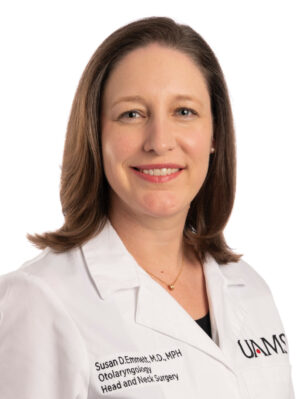The development of a low-cost, easy-to-use device to identify infection-related hearing loss in children has been kick-started by a $50,000 pilot grant from the University of Arkansas for Medical Sciences (UAMS) Translational Research Institute.

Susan Emmett, M.D., MPH, an associate professor in the UAMS College of Medicine Department of Otolaryngology-Head and Neck Surgery and director of the UAMS Center for Hearing Health Equity, said the pilot grant — one of five awarded to UAMS researchers who are conducting studies that impact rural health — is “a critical piece” of the initiative. Samantha Kleindienst Robler, Au.D., Ph.D., assistant professor and associate director of the UAMS Center for Hearing Health Equity, is another key faculty member leading the project.
The first phase of the project is already underway and involves the generation of hardware by biomedical engineers at Duke University and development of software by a company in South Africa to create a first-of-its kind, low-cost, cell phone–based tympanometer prototype, in collaboration with Emmett and Robler. UAMS and Arkansas Children’s Hospital audiologists will provide key guidance on this prototype. A first-in-human pilot study involving approximately 30 adults and children in Central Arkansas will follow.

“We are very grateful to TRI,” Emmett said, noting that the institute’s grant will allow the audiology guidance and first human studies at UAMS and ACH to be completed. “This grant is a critical step in us being able to bring this essential tool to rural and underserved areas that need it most.”
The second phase, to be funded by the National Institutes of Health, will involve use of the device in community settings in South Africa.
When the study is complete, “it has the potential to introduce something very tangible that will help the health of rural children in Arkansas, across the country and abroad,” Emmett said.
The ultimate goal is to develop a low-cost tympanometer that can be easily operated by schools and community health workers without any special training. The device would be used during routine screenings to identify children who are at risk of developing infection-related hearing loss or who are already experiencing it but haven’t been diagnosed. The teachers or community health workers would then help the children access affordable preventive care and treatment.
“Childhood hearing loss has a lifelong impact,” Emmett said, citing effects on speech and language development, the ability to learn in school and the ability to obtain a job. “But it could be prevented if we identify the problem early and make sure children have access to the care that they need.”
Robler said there is currently no standardized method of screening children for hearing loss. Although tympanometers have been around for decades, she said, current models can cost up to $10,000 apiece and require advanced training to operate.
The name of Emmett and Robler’s research project is Achieving Hearing Health Equity for Rural Children: Optimization of a Novel Mobile Health Tympanometer for Community-Based Hearing Screening.
Worldwide, 1.6 billion people are believed to have some degree of hearing loss, and 60% of hearing loss in children is preventable, according to the World Health Organization.
“That goes up to 75% in underserved communities,” Emmett said.
“This device will fill an important need because it helps to identify those children with preventable hearing loss caused by middle ear infections,” she said.
